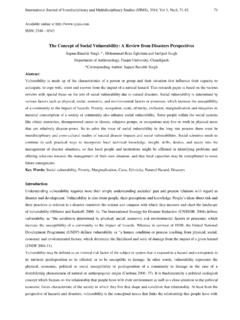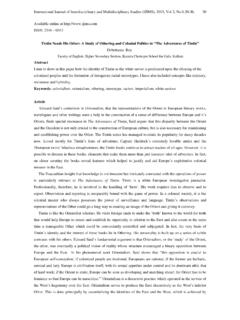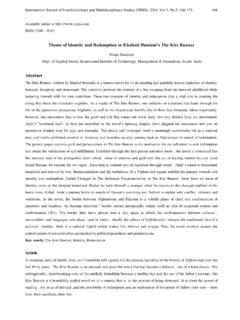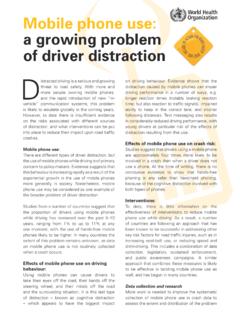Transcription of A Sociological Outlook of Mobile Phone Use in …
1 International Journal of Interdisciplinary and Multidisciplinary Studies (IJIMS), 2014, Vol 1, , 55-63. 55 Available online at ISSN: 2348 0343 A Sociological Outlook of Mobile Phone Use in Society Subhrajit Chatterjee Researcher, Dept. of Sociology (The University of Burdwan) and Teacher (Sociology ), Usatpur S. High School, East Medinipur, , India Abstract Mobile phones have become the most important and integral part of today s lifestyle and Mobile handset has become a widely recognized consumer artifact. Where the Mobile phones have great and huge merits there are also demerits as well. There are also gender differences in Mobile Phone usage. The primary objective of this article is to show the effect of Mobile phones on society and this article clearly show that the Mobile Phone has a huge effect on people and the way they interact with others. Keywords: Mobile Phone ; Object of Communication; Object of Identity, Self-esteem and Symbol; Memory Storage; Mobile Phone Surveillance; Role-integrative Functions; Mobile Banking and Mobile Payment; Mobile Phone Tracking; Mobile Phone Addiction.
2 Introduction In this Era, Mobile Phone has become fashionable to everybody since it is very handy; with a Mobile Phone in our hand we can solve many issues and keep most of information around the world. Mobile phones, assist you to the lot of business such as, make schedule of working, and keep in touch with their customers. Initially, when they first came out Mobile phones were only useful for communicating; now they are of multiple uses by them. With the arrival of sophisticated Mobile Phone it can be used for entertainment purposes also. Mobile Phone can be use as an effective the leisure time tool to convert human mind from stress level to free level. Although Mobile phones are perceived as devices that directly serve the individuals who own them, they are also social artifacts. As a communications technology, they support coordination with others. Additionally, Mobile telephony communicative practice is influenced by the social contexts in which the phones are used.
3 Communicative practice is also influenced by attributes of the owners lifestyle, including their social networks. Furthermore, because they are devices that are now present in a variety of contexts, and can be remotely and unpredictably activated, Mobile phones are subject to social scrutiny and play a role in the social world. They are surrounded by a system of actors who wittingly or unwittingly play a role in Mobile Phone conversation. Mobile phones solve problems and provide new channels of communication. We can access the entire world's information no matter where we are, just by using a device small enough to fit into one hand. Finally, a user s understanding of how Mobile telephony works is not only a matter of learning about its multiple technical components (hardware, software, and network services), but also of understanding service provider policies and integrating information garnered from sales, marketing, and billing communications[1].
4 Mobile telephony is rapidly becoming a feature of our culture, yet we do not understand its effects on communicative practice and behavior, especially with respect to the interaction and co-evolution of the technology and human activity. As wireless communications proliferate, empirical understanding of practice and social impacts of Mobile Phone becomes relevant for scholars and practitioners alike. So exploring the impact of Mobile phones on society is the theme of this article. Concept of Mobile Phone : A Mobile Phone (also known as a cellular Phone , cell Phone , and a hand Phone ) is a Phone that can make and receive telephone calls over a radio link while moving around a wide geographic area. It does so by connecting to a cellular network provided by a Mobile Phone operator, allowing access to the public telephone network. By contrast, a cordless telephone is used only within the short range of a single, private base station.
5 In addition to telephony, modern Mobile phones also support a wide variety of other services such as text messaging, MMS, email, Internet access, short-range wireless communications (infrared, Bluetooth), business applications, gaming and photography. Mobile phones that offer these and more general computing capabilities are referred to as Smart phones [2]. It can be said that the cultural meaning of the Mobile Phone has moved beyond that of a simple tool or appliance . It has become a commodity. Since virtually everyone owns a Mobile Phone and wears it openly, its value has moved beyond pure utility and into the realm of meaning. International Journal of Interdisciplinary and Multidisciplinary Studies (IJIMS), 2014, Vol 1, , 55-63. 56 History of the Mobile Phone : The history of the Mobile telephone involves both the history of technological development and an account of changing social and political frameworks into which the new technological developments become integrated.
6 The technological innovations of Mobile telephony were established from the 1940s, but it was not until the 1990s that adoption took off. The Mobile telephone has a global history in the sense that it has been developed or stalled by national politics as much as engineering challenges, exemplified by the different ways in which third generation (3G) licenses were sold in the UK, France, Germany, Sweden and the USA. Meanwhile there have been vast societal changes in terms of production and consumption, largely embedded in cross-national processes of globalization. Political influences on design have been accompanied by huge social changes, such as the development of travel and the increasing car culture during the period of the Mobile s early development[3]. Since Volta demonstrated electrical phenomena at the beginning of the 18th century, he has been succeeded by a whole silent, powerful technological revolution.
7 In 1834, Morse invented a wonderful trick to send information (to communicate ) consisting, above all, in a code and also in an electrical instrument that sent and received coded information. This instrument was the great-great-grandson of smoke, the tam-tam, fires, torches, messenger pigeons, signal telegraphs .., of texts on stone, on papyrus, on paper, of the printer s, of files and of books, of newspapers, in short, of so many artifacts (artifact means made with art ) invented by the tireless human being to communicate information and to communicate with each other. The telegraph was a real landmark. And then came subsequent advances: Graham Bell patents the telephone (remote voice) in Chicago in 1876. In 1900, Marconi solves the problem of sending one way information without the corset of wires, from which the radio and television derived, , the one way social media which nowadays is not only a reality but a permanent source of social conflict because of the political power they have illegitimately acquired.
8 But not only communication but information has been another concern of the human species: from the stones of Stonehenge, 3000 , the abacus, hand calculators, fingers (that is, "digits") to count with .. until electronics made the first computer possible, the ENIAC, in 1946. As from the nineteen seventies, all the foregoing converged, everything blended into a sort of crazy, passionate dance, information technology with telecommunications and the latter with the social media, shaping one and the same electronic technology to serve information and communication requirements. Here is where the Mobile Phone and written messaging over the Mobile was born. Child of Bell s telephone, for transmitting voice; child of the Morse telegraph, for transmitting text; child of Marconi s radio, for wireless transmitting of voice and texts. And, let us add, child of the first ENIAC computer, because the mobiles cellular network traffic is in itself a gigantic, multi-spatial, distributed computer [4].
9 In the UK the first land Mobile services were introduced in the 1940s and commercial Mobile telephony began in the USA in 1947 when AT&T began operating a highway service offering a radio-telephone service between New York and Boston. In the mid 1950s the first telephone quipped cars took to the road in Stockholm, the first users being a doctor-on-call and a bank-on-wheels. These first car-phones were too heavy, cumbersome, and expensive to use for more than a handful of subscribers and it was not until the mid 1960s that new equipment using transistors were brought on to the market. The first handheld Mobile cell Phone was demonstrated by Motorola in 1973. In the USA, in 1977, the Federal Communications Commission (FCC) authorized AT&T Bell Laboratories to install the first cellular telephone system. AT&T constructed and operated a prototype cellular analogue system and a year later, public trials of the new system were started.
10 The FCC was convinced that cellular radio was practical but the sheer size of America presented problems that were not to be encountered elsewhere. Hence, although the first working examples of cellular telephony emerged in America, the Nordic countries of Denmark, Norway and Sweden and also Finland were soon to overtake their lead. In 1981, this was followed by the simultaneous launch of the Nordic Mobile Telephone (NMT) system in Denmark, Finland, Norway and Sweden. Several other countries then followed in the early to mid-1980s. These first generation ("1G") systems could support far more simultaneous calls, but still used analog technology. In 1979, the first commercial cellular telephone system began operation in Tokyo and by the mid-1980s there was a significant expansion of services offered to the general public that rapidly attracted large numbers of subscribers wherever services were available.

















